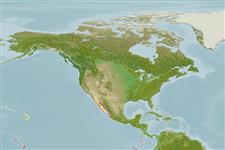Klassifizierung / Names
Namen | Synonyme | Catalog of Fishes(Gattung, Arten) | ITIS | CoL | WoRMS | Cloffa
>
Pleuronectiformes (Flatfishes) >
Cyclopsettidae (Sand whiffs)
Etymology: Etropus: Greek, etron, -on = lower abdomen + Greek, pous = feet; ciadi: Named for Centro de Investigacíon en Alimentacíon y Desarrollo (CIAD).
Eponymy: Not an eponym but an acronym that stands for Centro de Investigacion en Alimentacion y Desarrollo. Both the authors have held research positions in that Mexican institution. (Ref. 128868), visit book page.
Environment: milieu / climate zone / depth range / distribution range
Ökologie
seewasser demersal; tiefenbereich 8 - 40 m (Ref. 57761). Tropical
Eastern Pacific: Gulf of California.
Size / Gewicht / Alter
Maturity: Lm ? range ? - ? cm
Max length : 9.3 cm SL Männchen/unbestimmt; (Ref. 57761)
Found in soft bottoms at shallow depths (Ref. 57761).
Life cycle and mating behavior
Geschlechtsreife | Fortpflanzung | Ablaichen | Eier | Fecundity | Larven
Distinct pairing (Ref. 205).
van der Heiden, A.M. and H.G. Plascencia González, 2005. Etropus ciadi, a new endemic flatfish from the Gulf of California, Mexico (Pleuronectiformes: Paralichthyidae). Copeia 2005(3):470-478. (Ref. 57761)
IUCN Rote Liste Status (Ref. 130435: Version 2024-2)
Bedrohung für Menschen
Harmless
Nutzung durch Menschen
Tools
Zusatzinformationen
Download XML
Internet Quellen
Estimates based on models
Phylogenetic diversity index (Ref.
82804): PD
50 = 0.5020 [Uniqueness, from 0.5 = low to 2.0 = high].
Bayesian length-weight: a=0.00871 (0.00388 - 0.01954), b=3.03 (2.83 - 3.23), in cm total length, based on LWR estimates for this (Sub)family-body shape (Ref.
93245).
Trophic level (Ref.
69278): 3.4 ±0.2 se; based on size and trophs of closest relatives
Widerstandsfähigkeit (Ref.
120179): hoch, Verdopplung der Population dauert weniger als 15 Monate. (Preliminary K or Fecundity.).
Fishing Vulnerability (Ref.
59153): Low vulnerability (10 of 100).
